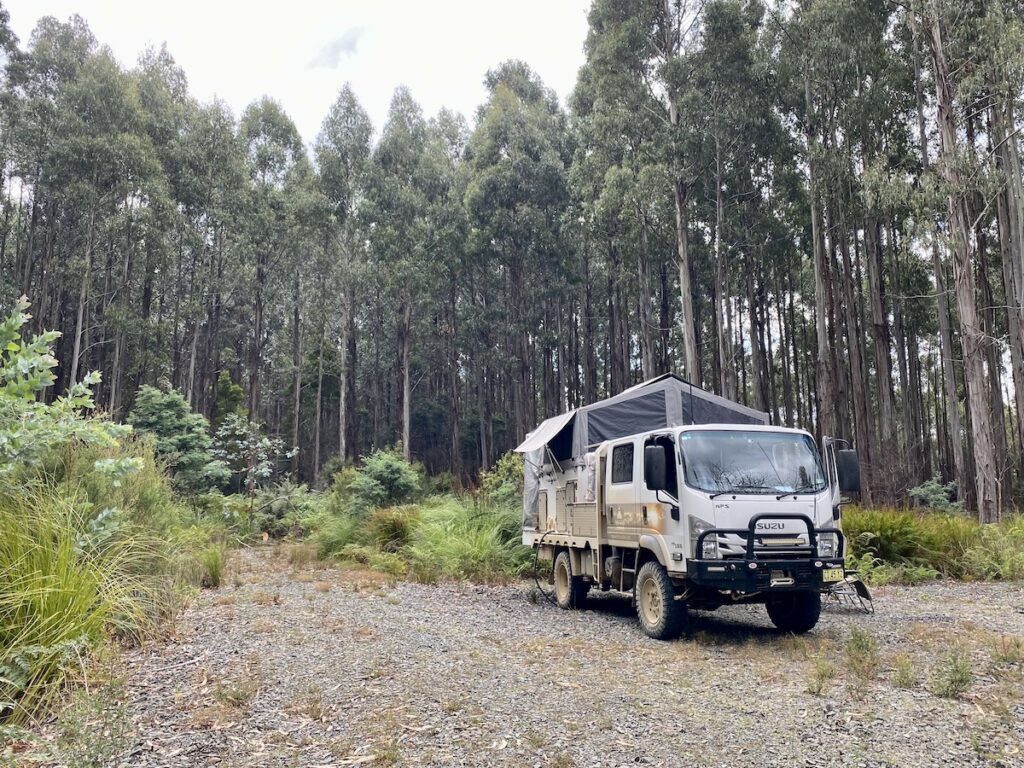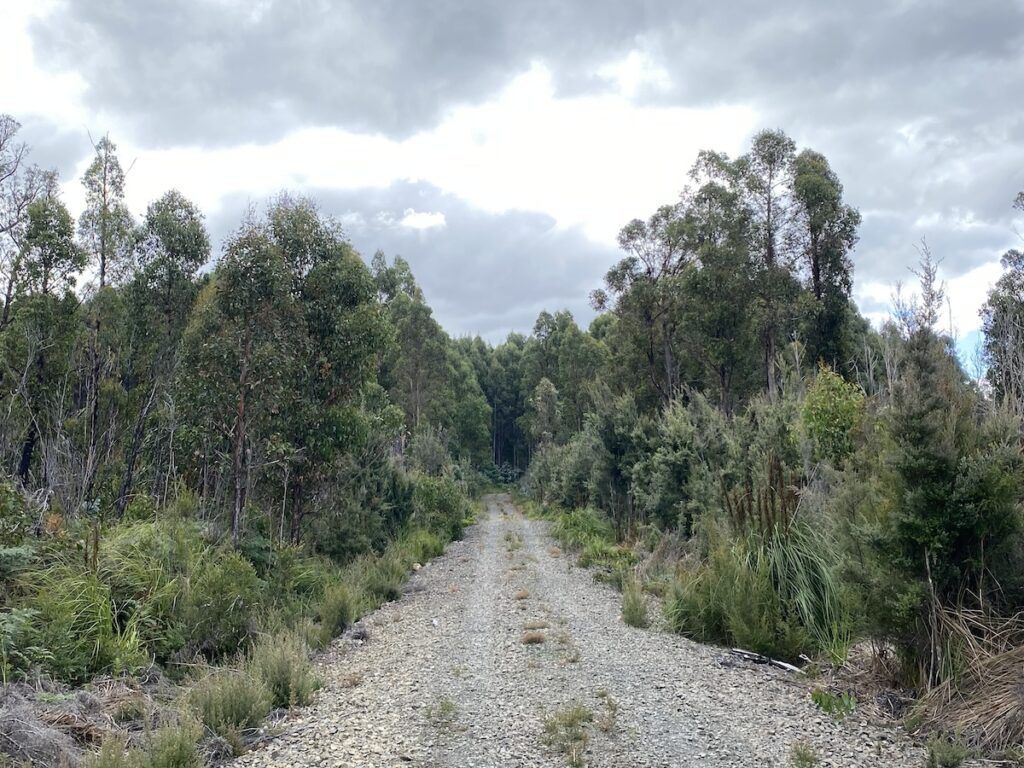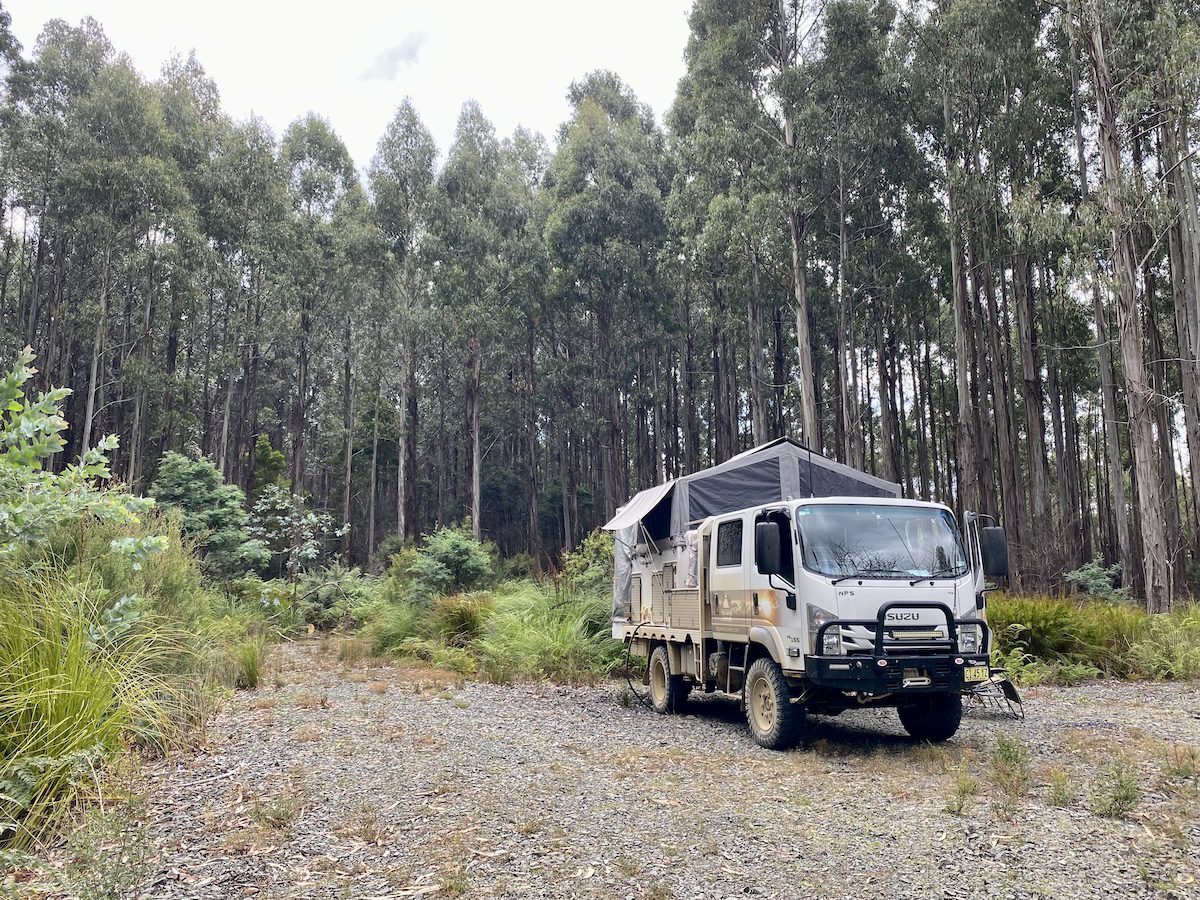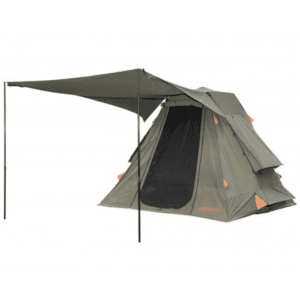Imagine you’re in the mountains of far southern Tasmania. You’ve had a great day exploring. You’ve followed the road as far south as you can drive, all the way to Cockle Bay.
It’s early March, the first few days of autumn.

The sun’s shining and the crystal clear waters of Cockle Bay are flat and shimmering in the sun. Cool temperate rainforest touches the coastline, with dozens of secluded campsites tucked just off the road among the tall trees.
You turn west off the tar and discover a network of old logging roads making their way through the magnificent mountain country. So you decide to explore.
Mid afternoon comes too soon and you find somewhere to camp overnight.
Turning off the main road, you find a short track ending in a cleared space. It’s an old logging track, well formed and overlain with blue metal. The cleared space was built for logging trucks to turn around in.

The track’s been there for a while, but it’s in good condition.
A young eucalypt plantation forms a U-shape around it. There’s a bit of wind, but nothing much. The trees are a good 20 metres away and about 30m high. It’s safe, even if the wind gets up.
Low scrubby Ti tree, cutting grass, and wattles fill the rest of the landscape, mostly on swampy ground. And the country gradually slopes from west to east… gently at the campsite, then falling away more quickly to the east.
This is where we found ourselves one brisk autumn afternoon. What could be better than camping in the bush, we thought. After a few weeks of jostling for a spot every night among the hoards of tourists, all our Christmases had come at once.
Or so we thought…
Mother Nature Turns On Us
We curled up in bed, snug and warm under blankets and a doona. The silence was deafening… perfect!
But that all changed in the early hours of the morning.
We both awoke at around 3:30am to the sound of wind roaring through the tops of the trees. And when I say roaring, I mean ROARING! It sounded like a huge wave rolling towards us, then over us and away to the east.
We were getting smashed by the Roaring Forties.
What are the Roaring Forties? They’re a band of intense winds found between 40 and 50 degrees latitude south of the equator. Mariners used them to skim across the ocean from west to east, at speeds unheard of in sailing ships.
Tasmania lies directly in the path of the Roaring Forties, as we discovered firsthand!
Mercifully the trees protected us and each gust would pass through the upper tree canopy.
But occasionally we’d get a rogue “wave”. We knew it was coming… the noise was more like a jet engine. It was next level. We could clearly hear it approach, then smash into our camper as a wall of wind.
The whole camper would rock violently, truck and all. And the sound of the wind trying to rip our canvas apart was frightening. We found out later, the gusts peaked at 135km/h. That’s equivalent to a Category 2 cyclone.
Then the giant “wave” would charge off through the trees, roaring as it went.
These massive gusts were terrifying. There we were, lying under a few sheets of canvas in the middle of a huge wind storm. We couldn’t pack up and run, as packing down would have been impossible in those wind gusts.
And chances are, there’d be a fallen tree blocking the road out. What would we do then?
We were caught there, feeling completely helpless and pretty scared. Mother Nature had turned on us… and we couldn’t do a thing. Our only option was to wait it out.
How our camper didn’t get torn to pieces is beyond me. It’s a testament to the build quality of our Wedgetail Camper.
Then just to test our resilience, Mother Nature decided to throw in a good dose of driving rain from daylight onwards. Let’s just say our pack down wasn’t exactly a barrel of laughs.
But on the positive side, we can now say we camped in the Roaring Forties and survived!
Looking back, we should have known better.
Complacency Is A Dangerous Thing
We had heard through the grapevine that Tassie was expecting a cold change, with big winds. And we had a vague notion it was due in the next couple of days.
We also knew Tasmania lies directly in the path of the Roaring Forties. So big winds are common.
But somehow we allowed complacency to creep in.
I always keep a close eye on the weather when travelling. We’re used to remote and outback travel. One thing you must keep an eye on when travelling remote is the weather. An unseasonal Outback rain event can leave you stranded for weeks in the middle of nowhere.
But this time I completely forgot to check the forecast before we lost phone reception. Perhaps it’s because everything is so close in Tasmania. After all, we were less than 30 minutes from the nearest town.
Yet we had no phone reception, and no one had a clue where we were (we hadn’t told anyone where we were going). We may as well have been in the middle of the Simpson Desert!
Even worse, we’d been in Tassie for a few weeks by then. So we knew how quickly the weather changes, especially in the mountains.
We simply weren’t prepared for what unfolded that night. A simple check of the forecast would have revealed multiple severe weather warnings across most of the state.
It just goes to show, even experienced travellers like ourselves can be caught out. Complacency is a dangerous thing.
How could we have avoided this?
Preparing And Researching
First and most obviously, we should have checked the forecast. Then we could have found a safer and more protected place to ride out the severe wind storm.
Next, we should have told someone where we were going. We did have a satellite phone. But even so, it’s pretty easy to send a text to a reliable family member or friend before you lose phone coverage.
Tasmania presents a whole set of challenges we haven’t faced before. Normally we avoid the cold country. But that’s impossible in Tassie if you want to get into the incredibly beautiful rugged mountain country.
If you’re searching for camping gear and accessories, Outback Equipment has a wide range available. Go here to find out more.
Do your research and be prepared when venturing into places with extreme climates. Whether it’s a trip across the Great Sandy Desert or a drive into the wild mountains of far southern Tasmania, the same rules apply.
Preparation and research will make your journey a whole lot easier. It’s time we heeded our own advice… especially when the Roaring Forties come roaring in!
Looking for more great articles on Tasmanian destinations? Then go here.

Get your Traveller’s Guides
… and a whole lot more at our FREE RESOURCES Page!
Any questions or comments? Go to the Comments below or join us on Pinterest, Facebook or YouTube.
Any errors or omissions are mine alone.



Sage advice, something that can easily be missed especially in Tassie where you could have walked into the next town without too much trouble, but it still feels remote… and no phone coverage.
Very true Dale. Even thought the distances between towns are short, in this wild country it’s easy to feel remote that’s for sure! Cheers, Andrew